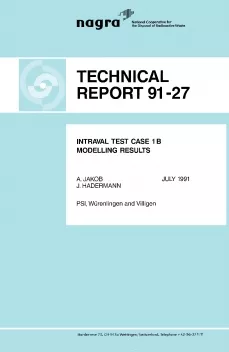
Technical Report NTB 91-27
Intraval Test Case 1BModelling results
This report presents results obtained within Phase I of the INTRAVAL study.
Six different models are fitted to the results of four infiltration experiments with 233U tracer on small samples of crystalline bore cores originating from deep drillings in Northern Switzerland.
Four of these are dual porosity media models taking into account advection and dispersion in water conducting zones (either tubelike veins or planar fractures), matrix diffusion out of these into pores of the solid phase, and either non-linear or linear sorption of the tracer onto inner surfaces. The remaining two are equivalent porous media models (excluding matrix diffusion) including either non-linear sorption onto surfaces of a single fissure family or linear sorption onto surfaces of several different fissure families.
The fits to the experimental data have been carried out by a Marquardt-Levenberg procedure yielding error estimates of the parameters, correlation coefficients and also, as a measure for the goodness of the fits, the minimum values of the χ2 merit function. The effects of different upstream boundary conditions are demonstrated and the penetration depth for matrix diffusion is discussed briefly for both alternative flow path scenarios.
The calculations show that the dual porosity media models are significantly more appropriate to the experimental data than the single porosity media concepts. Moreover, it is matrix diffusion rather than the non-linearity of the sorption isotherm which is responsible for the tailing part of the break-through curves.
The extracted parameter values for some models for both the linear and non-linear (Freundlich) sorption isotherms are consistent with the results of independent static batch sorption experiments. From the fits, it is generally not possible to discriminate between the two alternative flow path geometries.
On the basis of the modelling results, some proposals for further experiments are presented.
